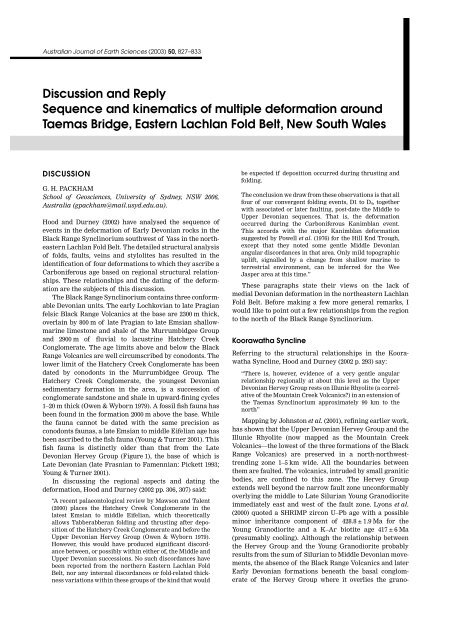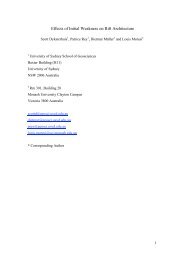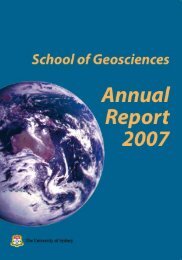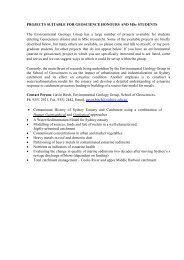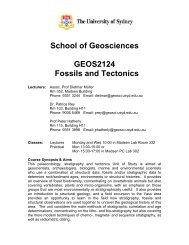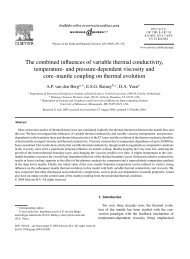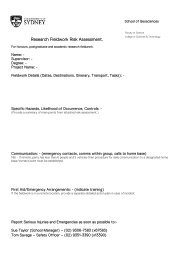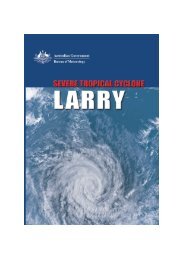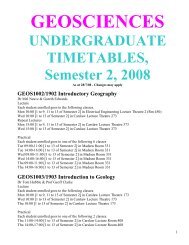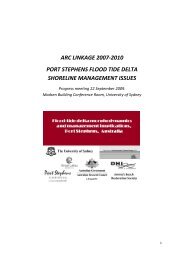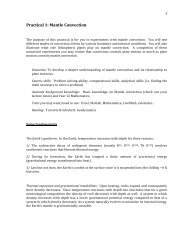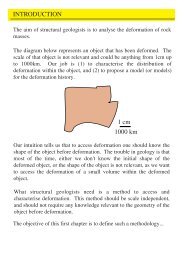View - School of Geosciences
View - School of Geosciences
View - School of Geosciences
Create successful ePaper yourself
Turn your PDF publications into a flip-book with our unique Google optimized e-Paper software.
Australian Journal <strong>of</strong> Earth Sciences (2003) 50, 827–833<br />
Discussion and Reply<br />
Sequence and kinematics <strong>of</strong> multiple deformation around<br />
Taemas Bridge, Eastern Lachlan Fold Belt, New South Wales<br />
DISCUSSION<br />
G. H. PACKHAM<br />
<strong>School</strong> <strong>of</strong> <strong>Geosciences</strong>, University <strong>of</strong> Sydney, NSW 2006,<br />
Australia (gpackham@mail.usyd.edu.au).<br />
Hood and Durney (2002) have analysed the sequence <strong>of</strong><br />
events in the deformation <strong>of</strong> Early Devonian rocks in the<br />
Black Range Synclinorium southwest <strong>of</strong> Yass in the northeastern<br />
Lachlan Fold Belt. The detailed structural analysis<br />
<strong>of</strong> folds, faults, veins and stylolites has resulted in the<br />
identification <strong>of</strong> four deformations to which they ascribe a<br />
Carboniferous age based on regional structural relationships.<br />
These relationships and the dating <strong>of</strong> the deformation<br />
are the subjects <strong>of</strong> this discussion.<br />
The Black Range Synclinorium contains three conformable<br />
Devonian units. The early Lochkovian to late Pragian<br />
felsic Black Range Volcanics at the base are 2300 m thick,<br />
overlain by 800 m <strong>of</strong> late Pragian to late Emsian shallowmarine<br />
limestone and shale <strong>of</strong> the Murrumbidgee Group<br />
and 2900 m <strong>of</strong> fluvial to lacustrine Hatchery Creek<br />
Conglomerate. The age limits above and below the Black<br />
Range Volcanics are well circumscribed by conodonts. The<br />
lower limit <strong>of</strong> the Hatchery Creek Conglomerate has been<br />
dated by conodonts in the Murrumbidgee Group. The<br />
Hatchery Creek Conglomerate, the youngest Devonian<br />
sedimentary formation in the area, is a succession <strong>of</strong><br />
conglomerate sandstone and shale in upward-fining cycles<br />
1–20 m thick (Owen & Wyborn 1979). A fossil fish fauna has<br />
been found in the formation 2000 m above the base. While<br />
the fauna cannot be dated with the same precision as<br />
conodonts faunas, a late Emsian to middle Eifelian age has<br />
been ascribed to the fish fauna (Young & Turner 2001). This<br />
fish fauna is distinctly older than that from the Late<br />
Devonian Hervey Group (Figure 1), the base <strong>of</strong> which is<br />
Late Devonian (late Frasnian to Famennian: Pickett 1993;<br />
Young & Turner 2001).<br />
In discussing the regional aspects and dating the<br />
deformation, Hood and Durney (2002 pp. 306, 307) said:<br />
“A recent palaeontological review by Mawson and Talent<br />
(2000) places the Hatchery Creek Conglomerate in the<br />
latest Emsian to middle Eifelian, which theoretically<br />
allows Tabberabberan folding and thrusting after deposition<br />
<strong>of</strong> the Hatchery Creek Conglomerate and before the<br />
Upper Devonian Hervey Group (Owen & Wyborn 1979).<br />
However, this would have produced significant discordance<br />
between, or possibly within either <strong>of</strong>, the Middle and<br />
Upper Devonian successions. No such discordances have<br />
been reported from the northern Eastern Lachlan Fold<br />
Belt, nor any internal discordances or fold-related thickness<br />
variations within these groups <strong>of</strong> the kind that would<br />
be expected if deposition occurred during thrusting and<br />
folding.<br />
The conclusion we draw from these observations is that all<br />
four <strong>of</strong> our convergent folding events, D1 to D 4, together<br />
with associated or later faulting, post-date the Middle to<br />
Upper Devonian sequences. That is, the deformation<br />
occurred during the Carboniferous Kanimblan event.<br />
This accords with the major Kanimblan deformation<br />
suggested by Powell et al. (1976) for the Hill End Trough,<br />
except that they noted some gentle Middle Devonian<br />
angular discordances in that area. Only mild topographic<br />
uplift, signalled by a change from shallow marine to<br />
terrestrial environment, can be inferred for the Wee<br />
Jasper area at this time.”<br />
These paragraphs state their views on the lack <strong>of</strong><br />
medial Devonian deformation in the northeastern Lachlan<br />
Fold Belt. Before making a few more general remarks, I<br />
would like to point out a few relationships from the region<br />
to the north <strong>of</strong> the Black Range Synclinorium.<br />
Koorawatha Syncline<br />
Referring to the structural relationships in the Koorawatha<br />
Syncline, Hood and Durney (2002 p. 293) say:<br />
“There is, however, evidence <strong>of</strong> a very gentle angular<br />
relationship regionally at about this level as the Upper<br />
Devonian Hervey Group rests on Illunie Rhyolite (a correlative<br />
<strong>of</strong> the Mountain Creek Volcanics?) in an extension <strong>of</strong><br />
the Taemas Synclinorium approximately 90 km to the<br />
north”<br />
Mapping by Johnston et al. (2001), refining earlier work,<br />
has shown that the Upper Devonian Hervey Group and the<br />
Illunie Rhyolite (now mapped as the Mountain Creek<br />
Volcanics—the lowest <strong>of</strong> the three formations <strong>of</strong> the Black<br />
Range Volcanics) are preserved in a north-northwesttrending<br />
zone 1–5 km wide. All the boundaries between<br />
them are faulted. The volcanics, intruded by small granitic<br />
bodies, are confined to this zone. The Hervey Group<br />
extends well beyond the narrow fault zone unconformably<br />
overlying the middle to Late Silurian Young Granodiorite<br />
immediately east and west <strong>of</strong> the fault zone. Lyons et al.<br />
(2000) quoted a SHRIMP zircon U–Pb age with a possible<br />
minor inheritance component <strong>of</strong> 428.8 ± 1.9 Ma for the<br />
Young Granodiorite and a K–Ar biotite age 417 ± 6 Ma<br />
(presumably cooling). Although the relationship between<br />
the Hervey Group and the Young Granodiorite probably<br />
results from the sum <strong>of</strong> Silurian to Middle Devonian movements,<br />
the absence <strong>of</strong> the Black Range Volcanics and later<br />
Early Devonian formations beneath the basal conglomerate<br />
<strong>of</strong> the Hervey Group where it overlies the grano-
828 Discussion and Reply<br />
diorite is indicative <strong>of</strong> a significant unconformity between<br />
the Hervey Group and the volcanics rather than a regional<br />
gentle angular relationship.<br />
Southern Cowra Trough<br />
The Moura Formation, a ?Pridoli turbiditic unit, in the<br />
western Cowra Trough has been intruded by the Eugowra<br />
Suite with zircon SHRIMP ages <strong>of</strong> 393.0 ± 2.5 and<br />
394.2 ± 2.1 Ma (Lyons et al. 2000). The zircon ages are close<br />
to the Tucker et al. (1998) Emsian–Eifelian boundary <strong>of</strong><br />
394 Ma and substantially younger than the Silurian–<br />
Devonian boundary placed at 418 Ma. The Hervey Group<br />
overlies the Eugowra Suite granites unconformably<br />
(Figure 1). The Moura Formation has been correlated<br />
lithologically by Lyons et al. (2000) with the Pridoli<br />
Gooligal Group 15 km to the east. The Gooligal Group is<br />
overlain by formations <strong>of</strong> the Gregra Group, which<br />
establishes that deposition in the Cowra Trough continued<br />
until at least into early Pragian time and the top could be<br />
as young as late Emsian (Meakin & Morgan 1999).<br />
The Silurian formations <strong>of</strong> the western part <strong>of</strong> the<br />
trough are overlain unconformably by the bimodal Dulladerry<br />
and Warrumba Volcanics in what has been called the<br />
Dulladerry Rift. The Warrumba Volcanics unconformably<br />
overlie the Young Granodiorite and Silurian Volcanics at<br />
the southern end <strong>of</strong> the Dulladerry Rift. SHRIMP zircon<br />
ages <strong>of</strong> 384.4 ± 3.4 and 382.7 ± 2.8 Ma (Lyons et al. 2000)<br />
confirm the late Givetian to earliest Frasnian age for the<br />
Warrumba Volcanics on the Tucker et al. (1998) Devonian<br />
time-scale suggested by the fish and plant remains.<br />
Powell et al. (1980) have documented a discordance <strong>of</strong> 3–30<br />
between the Dulladerry Volcanics and the Hervey Group<br />
and a much greater discordance <strong>of</strong> 27–97 with the Moura<br />
Formation (?Pridoli).<br />
The relationships indicate that there were a number <strong>of</strong><br />
orogenic events following the early Pragian (or later) end<br />
<strong>of</strong> deposition in the Cowra Trough. Deformation <strong>of</strong> the<br />
trough in Early Devonian time preceded the emplacement<br />
<strong>of</strong> the Eugowra Suite granites around the Emsian–Eifelian<br />
boundary. Upper Givetian to basal Famennian volcanics<br />
were deposited unconformably over the deformed Cowra<br />
Trough succession. The Eugowra granites were exposed<br />
either prior to or after the Dulladerry–Worrumba Volcanics,<br />
and both the volcanics and the granite were overlain<br />
unconformably by the Hervey Group fluvial deposits. Final<br />
deformation was in Carboniferous time. Allowing for the<br />
uncertainties in both the time-scale and zircon ages, the<br />
Eugowra Suite granites could be Eifelian and younger than<br />
the Hatchery Creek Conglomerate.<br />
Currowong and Tullamore Synclines<br />
Clear evidence <strong>of</strong> mid-Devonian tectonism is recorded<br />
60 km west <strong>of</strong> the Eugowra Granite where the Tullamore<br />
Syncline, containing the Hervey Group, trends a few<br />
degrees east <strong>of</strong> north (Figure 1). Unconformable beneath<br />
the Hervey Group on its southeastern flank trending a<br />
little west <strong>of</strong> north is the Currowong syncline containing<br />
Lower Devonian rocks <strong>of</strong> the Trundle Group (Lyons et al.<br />
2000). The difference in strike between the two synclines is<br />
~10. The Currowong Syncline contains the Carrawandool<br />
Volcanics dated at 403.2 ± 2.1 Ma (Emsian) that are<br />
intruded by two granite bodies: the Dalrida Granite, dated<br />
by SHRIMP at 395.4 ± 1.7 Ma and the Bundaburrah<br />
Granodiorite, which is unconformably overlain by the<br />
Hervey Group.<br />
Broader considerations<br />
Figure 1 Location <strong>of</strong> the Hatchery Creek Conglomerate, the<br />
distribution <strong>of</strong> Upper Devonian “Lambie Facies” formations in<br />
the eastern part <strong>of</strong> the Lachlan Fold Belt and the rocks unconformably<br />
underlying them. C, Cambrian; O, Ordovician; S,<br />
Silurian; Smg, mid-Silurian granite; Dl, Lower Devonian; Dlg,<br />
Lower Devonian granite; Dm, Middle Devonian; Dmv, Middle<br />
Devonian volcanics.<br />
On a broader scale in the eastern Lachlan Fold Belt, contrary<br />
to what is implied by Hood and Durney (2002) in the<br />
first paragraph quoted above, there is no location where<br />
deposition has been continuous from the Early Devonian<br />
to Late Devonian and the Early Middle Devonian to Late<br />
Devonian.<br />
Only two early Middle Devonian sedimentary formations<br />
are known in the region east <strong>of</strong> the Gilmore Fault.<br />
One is the Hatchery Creek Conglomerate, discussed above,<br />
and the other is on the northwestern corner <strong>of</strong> the Mt<br />
Frome Syncline (Figure 1) where the Mt Frome Limestone<br />
extends into the first conodont zone <strong>of</strong> the Middle Devonian<br />
and is overlain conformably by the Boogledie Formation,
Multiple deformation around Taemas Bridge 829<br />
a succession <strong>of</strong> feldspatholithic sandstone, shale and<br />
conglomerate (Meakin & Morgan 1999). This is overlain<br />
unconformably by the basal beds <strong>of</strong> the Upper Devonian Mt<br />
Frome Group. Elsewhere, east <strong>of</strong> the Gilmore Fault, the last<br />
recorded Early Devonian marine sediments are variously<br />
late Lochkovian to Emsian.<br />
Possible late Middle to early Late Devonian formations<br />
occur in two areas: (i) the Dulladerry Rift post-dating the<br />
Cowra Trough discussed above; and (ii) the Comerong<br />
Volcanics and the Boyd Volcanic Complex, which are suites<br />
that underlie the coastal strip <strong>of</strong> the Upper Devonian<br />
Merrimbula Group. The latter volcanics overlie Ordovician<br />
quartz-rich facies rocks and locally part <strong>of</strong> the Early<br />
Devonian Bega Batholith. There are no older Devonian<br />
sedimentary formations underlying these volcanics. In<br />
both cases, the volcanics are bimodal and are supposedly<br />
deposited in an extensional tectonic environment (Scheibner<br />
& Basden 1998).<br />
The Upper Devonian formations in the Lachlan Fold Belt<br />
east <strong>of</strong> the Gilmore Fault post-dating the volcanics (‘Lambie<br />
Facies’) are universally unconformable on older rocks<br />
(Figure 1). They are predominantly quartz-rich fluvial<br />
and alluvial facies deposits with a marine transgression<br />
early in the depositional history. On present biostratigraphic<br />
data, the base is late Frasnian to early Famennian.<br />
If it is diachronous, it could be a little older in the east. The<br />
Hatchery Creek Conglomerate, rather than being part <strong>of</strong> a<br />
diachronous ‘molasse’ overlap sequence, is better regarded<br />
as a short-term incursion <strong>of</strong> the fluvial facies <strong>of</strong> the<br />
Mulga Downs Group onto the western flank <strong>of</strong> the eastern<br />
Lachlan Fold Belt.<br />
An assessment <strong>of</strong> Middle Devonian deformation around<br />
the Hill End Trough was made in a series <strong>of</strong> studies by<br />
Powell and coworkers (Powell et al. 1976; Powell & Edgecombe<br />
1978) that focused on the angular discordances<br />
between Upper and Lower Devonian rocks in thinner and<br />
less-disturbed successions on the palaeogeographical<br />
highs east and west <strong>of</strong> the trough. Even there they found<br />
that half <strong>of</strong> the 130 angular discordances located were<br />
between 10 and 20. The significant basal Upper Devonian<br />
unconformities on both highs that cut across the Lower<br />
Devonian and Silurian strata to expose Ordovician formations<br />
(Figure 1) were not taken into account.<br />
The question <strong>of</strong> the timing <strong>of</strong> deformation <strong>of</strong> the Hill<br />
End Trough was an issue I revisited (Packham 1999),<br />
reasserting my long-held view that it occurred in Middle<br />
Devonian time. The trough contains a conformable thick<br />
succession <strong>of</strong> Ludlow to upper Emsian turbidite facies<br />
rocks, the last deep-water sediments in the northeast<br />
Lachlan Fold Belt. As Upper Devonian formations are<br />
confined to the flanking highs, indirect arguments have<br />
been used to deduce the time <strong>of</strong> its deformation.<br />
The axial trough fill has been metamorphosed up to<br />
biotite grade. In samples from the Hill End goldfield, Lu<br />
et al. (1996b) obtained<br />
40<br />
Ar/ 39 Ar dates on biotite <strong>of</strong><br />
359.8 ± 0.6 and 358.2 ± 0.4 Ma, close to the Devonian–<br />
Carboniferous boundary, for the cooling <strong>of</strong> regional metamorphic<br />
biotite through the closure temperature for argon.<br />
Lu et al. (1996a, b) had found from palaeothermometry and<br />
palaeobarometric studies together with dating <strong>of</strong> the mineralisation<br />
phases that pressure had remained high and<br />
temperatures elevated well into Carboniferous time. I<br />
argued that these data indicated Middle Devonian deformation,<br />
metamorphism and limited exhumation followed by<br />
consequential slow cooling during and after the deposition<br />
<strong>of</strong> the flanking Upper Devonian formations prior to deformation<br />
later in the Early Carboniferous.<br />
The structural relationships in the Koorawatha Syncline,<br />
the Southern Cowra Trough the Currowong and<br />
Tullamore Synclines provide clear evidence <strong>of</strong> deformation<br />
in the middle part <strong>of</strong> the Devonian. This is supported<br />
by the unconformable relationship <strong>of</strong> Upper Devonian<br />
formations to older units on the Molong and Capertee<br />
High, a deduced Middle Devonian deformation <strong>of</strong> the Hill<br />
End Trough and the regional unconformity at the base <strong>of</strong><br />
the Upper Devonian “Lambie Facies” throughout the<br />
eastern Lachlan Fold belt. This clear evidence for regional<br />
Tabberabberan events means that the four deformations<br />
identified by Hood and Durney (2002) in the Black Range<br />
Synclinorium cannot be definitively dated as Carboniferous<br />
in age. Some, and perhaps all <strong>of</strong> them, could have<br />
occurred in Middle Devonian time.<br />
REPLY<br />
D. W. DURNEY 1 and D. I. A. HOOD 2 *<br />
1<br />
Department <strong>of</strong> Earth & Planetary Science, Macquarie<br />
University, NSW 2109, Australia.<br />
2<br />
4 Cheriton Avenue, Castle Hill, NSW 2154, Australia.<br />
Packham raises some fundamental points about interpretation<br />
<strong>of</strong> the sub-Upper Devonian unconformity in the<br />
Lachlan Fold Belt. He questions the Carboniferous age <strong>of</strong><br />
the four fold- and cleavage-forming episodes in Lower to<br />
lower Middle Devonian units <strong>of</strong> the Black Range Synclinorium<br />
(Hood & Durney 2002) that we had deduced from<br />
structural correlation with deformed Upper Devonian<br />
rocks and suggests that ‘Some, and perhaps all <strong>of</strong> them’<br />
could be Middle Devonian. He evidently regards this<br />
method as ‘indirect’ or not ‘definitiv[e]’ and points,<br />
instead, to the widespread unconformable relations <strong>of</strong><br />
Upper Devonian units east <strong>of</strong> the Gilmore Fault (Figure 1)<br />
and to a thermochronological interpretation (Packham<br />
1999) <strong>of</strong> analytical data (Lu et al. 1996b, c) from the Hill<br />
End area.<br />
This general subject was discussed by Powell and coworkers<br />
and Packham (1999), but we find those assessments<br />
to be incomplete. (For example, they discussed mainly a<br />
single fold episode; we four. They assumed that the mild<br />
angular unconformable relations around the Hill End<br />
Trough were due to fold deformations; we do not.) Packham’s<br />
comments raise questions about what causes unconformities,<br />
a point that we feel must be addressed if further<br />
progress is to be made. We therefore explain what we<br />
consider to be the primary tools for assessing whether<br />
unconformities are due to folding—geometric and<br />
structural criteria—and enquire how they apply to the<br />
ca Middle Devonian discordances that he mentions.<br />
Likewise, we examine the evidence and reasoning for the<br />
*Corresponding author: david_hood@royalsun.com.au
830 Discussion and Reply<br />
ca Middle Devonian metamorphism that he (Packham 1999)<br />
assumed for the Hill End Goldfield.<br />
Geological ages here allow for uncertainties in radiometric<br />
time-scales referred to in Packham (1999).<br />
Folding significance <strong>of</strong> unconformities<br />
Packham describes the process that produces unconformities<br />
as ‘deformation’ or ‘orogenic events’. However, these<br />
terms are not sufficient to indicate the kind <strong>of</strong> movement<br />
(which may be uplift, doming, sag, tilting, faulting or<br />
folding (possibly due to no horizontal strain), extension,<br />
contraction, wrench motion, intrusion, volcanic collapse,<br />
etc.). Alternatively, they may perhaps assume a particular<br />
kind <strong>of</strong> movement (say, folding).<br />
What we tried to convey by the expression ‘significant<br />
discordance’ (Hood & Durney 2002 p. 306) was not a ‘lack <strong>of</strong><br />
medial Devonian deformation’ in the broad sense nor<br />
‘continuous’ deposition (Packham) but an angular relation<br />
that is significant in terms <strong>of</strong> ‘folding and thrusting’. This<br />
is the point that we were addressing and which is the crux<br />
<strong>of</strong> the matter now under discussion: not whether there are<br />
one or more unconformities, even ones that may cut<br />
through large sections <strong>of</strong> stratigraphy, but whether they<br />
were produced by folding. (For present purposes we<br />
include also folds produced by wrench-kinematic deformation:<br />
i.e. folding that involves horizontal shortening.) This<br />
type <strong>of</strong> deformation has some specific geometric and kinematic<br />
characteristics.<br />
For example, the folds that we studied around Taemas<br />
Bridge (Hood & Durney 2002), and which are Packham<br />
candidates for causing a Middle Devonian unconformity,<br />
show limb dips that are moderate to steep (>30), that are<br />
widely distributed at those angles, that alternate on<br />
regular wavelengths and have one or more preferred<br />
strikes. These are characteristics <strong>of</strong> folding by horizontal<br />
shortening—i.e. by buckling (Price & Cosgrove 1990)—as<br />
we had verified from kinematic observations (Hood &<br />
Durney 2002). Ductile strain and associated cleavage<br />
development is another. Primarily, the dip pattern <strong>of</strong> the<br />
folds should be reflected by a corresponding discordance<br />
pattern at the unconformity, and this pattern and its<br />
associated small-scale deformation structures should be<br />
missing or weaker (i.e. not fully correlatable) in the<br />
younger strata.<br />
Do the Middle Devonian unconformities show fold<br />
movement?<br />
(1) Angle <strong>of</strong> discordance (sub-Upper Devonian<br />
unconformity) On magnitude <strong>of</strong> angularity alone, a<br />
typical limb dip <strong>of</strong> around 45 or more, as found for many<br />
<strong>of</strong> the folds east <strong>of</strong> the Coolac–Narromine Fault (or even<br />
30, allowing for some tightening <strong>of</strong> early folds by later<br />
deformation), if eroded and overlain by Upper Devonian<br />
sedimentary rocks, would be well beyond the majority <strong>of</strong><br />
known discordances at the base <strong>of</strong> the Upper Devonian or<br />
Lambian unconformity. The quoted discordances are: 73%<br />
Multiple deformation around Taemas Bridge 831<br />
appear to be restricted to the Currowong Syncline (Lyons<br />
et al. 2000; Glen et al. 2002; Packham) and Jesse Syncline<br />
(Glen & Watkins 1999) and grade into sub-concordance<br />
north and south, respectively, along strike. Consistent, very<br />
gentle to gentle, tilts over many kilometres (plus or minus<br />
some faulting: Glen & Watkins 1999) seem much more<br />
prevalent. The Warrumba Volcanics and Dulladerry<br />
Volcanics are clear examples representing the early Late<br />
Devonian phase <strong>of</strong> the unconformity movement in the<br />
Cowra Trough area. These upper Middle to lowermost<br />
Upper Devonian (Packham) volcanics thicken continuously<br />
from 0 m to up to ~2500 m over about 20 km northwards<br />
beneath the Hervey Group (after mapping by<br />
Conolly 1965; Raymond & Pogson 1998; Raymond et al.<br />
2001). The data indicate tilt components <strong>of</strong> ~6 and ~8 for<br />
the respective volcanics to the north. Significantly, the<br />
discordance components across strike <strong>of</strong> the dominant<br />
sub-meridional folds are similar or less and are likewise<br />
consistently orientated, implying no folding <strong>of</strong> the<br />
volcanics prior to deposition <strong>of</strong> the Upper Devonian.<br />
(5) Sub-upper Middle Devonian unconformity Nonconformable<br />
relationships <strong>of</strong> the Dulladerry Volcanics and<br />
coeval Comerong Volcanics/Boyd Volcanic Complex with<br />
underlying Emsian–Eifelian and Early Devonian granites<br />
(Packham) represent a further and older erosion phase,<br />
some time within the early Eifelian to early Givetian<br />
interval. Angularity cannot be assessed from these<br />
relations and so must be sought elsewhere. The sites<br />
involving Upper Silurian to lower Middle Devonian strata<br />
mentioned in point (1) would incorporate any movement <strong>of</strong><br />
this age. These, together with known conformable<br />
relations <strong>of</strong> lower Middle Devonian Hatchery Creek<br />
Conglomerate (discussed in Hood & Durney 2002) and<br />
Boogledie Formation (Packham) with underlying Lower<br />
Devonian limestones, suggest generally low to no angularity<br />
for this phase.<br />
(6) Moura Formation The single case <strong>of</strong> consistently<br />
higher discordance angle noted by Packham—the gentle to<br />
moderate 26 and 42 local-means <strong>of</strong> Powell et al. (1980)<br />
between the ?Siluro-Devonian Moura Formation and<br />
Upper Devonian in the Parkes Syncline—may not<br />
represent ca Middle Devonian movement as the tilting<br />
may have occurred prior to or during intrusion <strong>of</strong> the<br />
late Early Devonian Eugowra Granite.<br />
What are the relationships between folds in Upper<br />
Devonian and Lower to Middle Devonian strata?<br />
Figure 2 Early Carboniferous multiple folding <strong>of</strong> the Hervey<br />
Group, Gilgandra–Cowra–Yass Zone. Interpreted fold groups are<br />
identified by line symbols; faults and regolith are omitted for<br />
clarity. B, Bumberry Syncline; H, Hervey Syncline; K, Koorawatha<br />
Syncline; M, Mandagery Syncline; P, Parkes Syncline.<br />
Geology after Conolly (1965) and references in Durney (2000);<br />
interpretation by Durney.<br />
Where the preserved Upper Devonian does not rest directly<br />
on the older Devonian units, folds and cleavages should be<br />
structurally correlatable between the two successions if<br />
they had both been affected by the same folding (as<br />
opposed to tilting) at a later time. To minimise possible<br />
complications from (i) different degrees <strong>of</strong> folding due to<br />
different underlying crustal competencies and (ii) spatial<br />
variation <strong>of</strong> dominant fold trend, we compare folds and<br />
cleavage in large areas from the same structural zone—the<br />
Gilgandra–Cowra–Yass Zone <strong>of</strong> Scheibner and Basden<br />
(1998)—as mentioned briefly in Hood and Durney (2002).<br />
These are (i) the predominantly Lower Devonian rocks <strong>of</strong><br />
the Black Range Synclinorium (Hood & Durney 2002) and<br />
(ii) the Upper Devonian Hervey Group to the north<br />
(Figure 2: south <strong>of</strong> the Cowra Trough in Figure 1). Here, we<br />
summarise the correlation for seven independent structural<br />
attributes, with between one and four orientation<br />
subsets each.<br />
(1) Fold trend As shown in Figure 2, the Hervey Group<br />
contains an identical range <strong>of</strong> fold trends and very similar<br />
orientationally groups [northeast–north-northeast, northnortheast–north<br />
(possibly separate north-northeast and<br />
north trends in the Koorawatha Syncline) and northnorthwest–west-northwest]<br />
to those in the Black Range<br />
Synclinorium (northeast, north-northeast–north, northnorthwest–northwest<br />
and west-northwest–west: Hood &<br />
Durney 2002 figure 13).<br />
(2) Fold sequence Overall fold sequence in the Hervey<br />
Group has not yet been fully established owing to a predominance<br />
<strong>of</strong> dome–basin interference patterns in these rocks<br />
(Durney 2000). However, a reliable time relation (in Scott<br />
2000 p. 60) was obtained from steep tilting <strong>of</strong> northeast-foldrelated<br />
vein arrays on the east limb <strong>of</strong> the dominant north–<br />
north-northeast-trending Mandagery Syncline (Figure 2)
832 Discussion and Reply<br />
at its northern end. As this is the same orientation and<br />
sequence as F 1 (northeast) and F 2 (north–north-northeast)<br />
folds in the Black Range Synclinorium (Hood & Durney<br />
2002), it implies that the earliest known folding in the Black<br />
Range Synclinorium affected also the Hervey Group in this<br />
area.<br />
(3) Fold tightness Interlimb-angle ranges from gentle<br />
to tight in both the Hervey Group (Powell et al. 1980;<br />
Raymond & Pogson 1998; Durney 2000 table 2.1) and the<br />
Black Range Synclinorium (Hood & Durney 2002 table 1).<br />
The dominant folds (north-northeast to north in the<br />
Hervey Group and north-northeast to north-northwest in<br />
the Black Range Synclinorium) are mainly open to close in<br />
both areas (Durney 2000; Hood & Durney 2002). Gentle limb<br />
dips in parts <strong>of</strong> the Parkes and Bumberry Synclines<br />
(Figure 2) may be attributable to competent granite basement<br />
near those sites (Powell et al. 1980).<br />
(4) Fold continuity The major north-northwest (F 3)<br />
syncline on the eastern side <strong>of</strong> the Black Range Synclinorium<br />
(the Taemas Synclinorium) continues north-northwestwards,<br />
via a strip <strong>of</strong> downfaulted Mountain Creek<br />
Volcanics, into similarly folded Hervey Group rocks <strong>of</strong> the<br />
Koorawatha Syncline (Brunker & Offenberg 1970; Johnston<br />
et al. 2001). These structures are part <strong>of</strong> the one major<br />
downwarp: Scheibner’s (1976) Cowra–Yass Synclinoral<br />
Zone.<br />
(5) Kinematics Kinematics <strong>of</strong> the inferred earliest<br />
(northeast–north-northeast or northeast) folds are thruststyle<br />
in both areas. For the inferred second (north-northeast–north)<br />
generation, they are thrust-style in the<br />
Hervey Group and wrench-style in the Black Range<br />
Synclinorium (Durney 2000 table 2.1; Hood & Durney 2002;<br />
figure 13).<br />
(6) Cleavage trend The dominant penetrative cleavage<br />
in mudrocks and penetrative and stripy cleavages in sandstones<br />
locally trend about north-northeast or northwest in<br />
both areas (Scott 2000 figures 2.13, 4.9; D. W. Durney unpubl.<br />
data).<br />
(7) Fissility anisotropy type Moderately to strongly<br />
cleaved mudrocks <strong>of</strong> both successions show the same,<br />
rather unusual, type <strong>of</strong> three-dimensional fissility anisotropy<br />
(Durney & Kisch 1994): steeply plunging, beddingtransverse<br />
blades, in places verging on transverse pencils<br />
(Scott 2000 figures 2.9–2.12, 4.6). Both regions have therefore<br />
experienced similar, special, deformation histories,<br />
explained as accumulated non-coaxial shortening associated<br />
with successive folding on widely divergent trends<br />
(Durney 2000; Durney & Hood 2002).<br />
Is there Middle Devonian metamorphism in the<br />
Hill End Trough?<br />
Packham refers to his 1999 interpretation <strong>of</strong> Lu et al.’s<br />
(1996b) radiometric dating in the Hill End Trough as an<br />
example <strong>of</strong> ‘Middle Devonian’ (375–364 Ma) folding and<br />
metamorphism. [Those authors considered their data to<br />
indicate ‘Carboniferous’ (363–359 Ma) folding and metamorphism.]<br />
The Hill End Goldfield, where Lu et al.’s (1996b) samples<br />
come from, shows evidence <strong>of</strong> both hydrothermal activity<br />
(bedding-parallel quartz–gold vein mineralisation) and<br />
regional metamorphism (biotite-bearing rocks with penetrative<br />
cleavage). The bedding-parallel veins, together with<br />
bedding, are folded and boudinaged and are internally<br />
deformed and recrystallised to varying degrees (Seccombe<br />
& Hicks 1989; Windh 1995). The veins thus began to<br />
form ‘before, or during the earliest stage <strong>of</strong>, the regional<br />
folding’ (Windh 1995 p. 1768). (They also show later<br />
development by slip and dilation during the folding.) Lu<br />
et al. (1996b) gave 380–370 Ma (about late Middle to early<br />
Late Devonian, depending on the time-scale used) as the<br />
age <strong>of</strong> this stage, based on 40 Ar/ 39 Ar dating <strong>of</strong> ‘early veinmuscovite’.<br />
(1) Peak temperature The 420C peak temperature<br />
that Seccombe et al. (1993 p. 424) and Packham (1999 p. 26)<br />
equated to their respective peak metamorphisms was<br />
obtained from alteration-carbonate porphyroblasts (Seccombe<br />
& Hicks 1989) associated with the mineralised<br />
bedding-parallel veins (Seccombe & Hicks 1989; Windh<br />
1995). Therefore, the porphyroblasts definitively represent<br />
a hydrothermal event, not a metamorphic one. As they are<br />
‘pretectonic or early syntectonic’ with respect to cleavage<br />
(Seccombe & Hicks 1989 p. 261; Windh 1995 figure 6D), they<br />
must pre-date the regional metamorphism, which should<br />
post-date (Packham 1999) or perhaps syn-date the main<br />
deformation. Thus we find no basis for assigning the early<br />
420C event to metamorphism.<br />
(2) Peak pressure The 2.9 kb pressure estimate (290<br />
MPa or ~11 km burial: Packham 1999) that Seccombe and<br />
Hicks (1989) and Lu and Seccombe (1993) linked to the 420C<br />
temperature was based on ‘metamorphic white mica’ from<br />
the host rocks (Lu & Seccombe 1993 p. 311) rather than on<br />
muscovite from the veins. It therefore relates to the metamorphism.<br />
As the 420C hydrothermal event was not<br />
coincident with the metamorphism, burial during the<br />
former is undefined. It could thus have been much less than<br />
11 km, consistent with its hydrothermal nature and timing<br />
before any deposition <strong>of</strong> Upper Devonian sediment and<br />
later fold-related thickening <strong>of</strong> the sediments.<br />
Conclusions<br />
We find the terms ‘deformation’ and ‘orogeny’ insufficient<br />
to convey the nature <strong>of</strong> the Tabberabberan movement in<br />
the northeastern Lachlan Fold Belt. The two oldest Middle<br />
Devonian stratigraphical formations appear to be conformable<br />
on their respective late Emsian and earliest<br />
Eifelian limestone substrates. The Middle to early Late<br />
Devonian movements that were responsible for the<br />
Lambian unconformity in the region show predominantly<br />
very gentle (
Multiple deformation around Taemas Bridge 833<br />
Acknowledgements<br />
Pat Conaghan and Phil Seccombe are thanked for comments<br />
that led to improvements.<br />
REFERENCES<br />
BRUNKER R. L. & OFFENBERG A. C. 1970. Goulburn 1:250 000 Geological<br />
Sheet, SI/55–12. Geological Survey <strong>of</strong> New South Wales, Sydney.<br />
CONOLLY J. R. 1965. The stratigraphy <strong>of</strong> the Hervey Group in central<br />
New South Wales. Journal and Proceedings <strong>of</strong> the Royal Society <strong>of</strong><br />
New South Wales 98, 37–83.<br />
DURNEY D. W. 2000. Background discussion for the Taemas and Murga<br />
stops. In: Scott M. M. ed. Heterogeneous Ductile to Brittle Structures<br />
in the Eastern Lachlan Fold Belt, 15th Australian Geological<br />
Convention Field Guide FA2, pp. 15–22. Geological Society <strong>of</strong><br />
Australia, Sydney.<br />
DURNEY D. & HOOD D. 2002. Relation <strong>of</strong> penetrative cleavage to the<br />
tectonic Y-axis in an area <strong>of</strong> non-coaxial shortening in the YZplane,<br />
Taemas, New South Wales. In: Lebit H., Luneburg C.,<br />
Hudleston P. & Ramsay J. eds. Three-dimensional Flow, Fabric<br />
Development and Strain in Deformed Rocks and Significance for<br />
Mountain Building Processes: New Approaches, pp. 27–28. Geological<br />
Society <strong>of</strong> America Penrose Conference, Monte Verita,<br />
Abstract Volume.<br />
DURNEY D. W. & KISCH H. J. 1994. A field classification and intensity<br />
scale for first generation cleavages. AGSO Journal <strong>of</strong> Australian<br />
Geology & Geophysics 15, 257–295.<br />
FLEUTY M. J. 1964. The description <strong>of</strong> folds. Proceedings <strong>of</strong> the<br />
Geologists Association 75, 461–492.<br />
GLEN R. A., KORSCH R. J., DIREEN N. G., JONES L. E. A., JOHNSTONE D. W.,<br />
LAWRIE K. C., FINLAYSON D. M. & SHAW R. D. 2002. Crustal structure<br />
<strong>of</strong> the Ordovician Macquarie Arc, Eastern Lachlan Orogen, based<br />
on seismic-reflection pr<strong>of</strong>iling. Australian Journal <strong>of</strong> Earth<br />
Sciences 49, 323–348.<br />
GLEN R. A. & WATKINS J. J. 1999. Implications <strong>of</strong> Middle Devonian<br />
deformation <strong>of</strong> the eastern part <strong>of</strong> the Hill End Trough, Lachlan<br />
Orogen, New South Wales. Australian Journal <strong>of</strong> Earth Sciences<br />
46, 35–52.<br />
HOOD D. I. A. & DURNEY D. W. 2002. Sequence and kinematics <strong>of</strong><br />
multiple deformation around Taemas Bridge, Eastern Lachlan<br />
Fold Belt, New South Wales. Australian Journal <strong>of</strong> Earth Sciences<br />
49, 291–309.<br />
JOHNSTON A. J., POGSON D. J., THOMAS O. D., WATKINS J. J. & GLEN R. A.<br />
2001. Boorowa 1:100 000 Geological Sheet 8629 (provisional 1st<br />
edition). Geological Survey <strong>of</strong> New South Wales, Orange.<br />
LU J. & SECCOMBE P. K. 1993. Fluid evolution in a slate-belt gold<br />
deposit. Mineralium Deposita 28, 310–323.<br />
LU J., SECCOMBE P. K. & ELDRIDGE C. S. 1996a. SHRIMP S-isotope<br />
evidence for fluid mixing during gold mineralization in a slatebelt<br />
gold deposit (Hill, End, New South Wales, Australia).<br />
Chemical Geology 127, 229–240.<br />
LU J., SECCOMBE P. K., FOSTER D. & ANDREW A. S. 1996b. Timing <strong>of</strong><br />
mineralization and source fluids in a slate-belt auriferous vein<br />
system, Hill End goldfield, NSW, Australia: evidence from 40 Ar/<br />
39<br />
Ar dating and O- and H-isotopes. Lithos 38, 147–165.<br />
LU J., SECCOMBE P. K. & WALSHE J. L. 1996c. Conditions on chlorite<br />
growth in the Hill End Goldfield, New South Wales, Australia:<br />
some predictions and evaluations. Canadian Mineralogist 34,<br />
9–21.<br />
LYONS P., RAYMOND O. L. & DUGGAN M. B. 2000. Forbes 1:250 000<br />
Geological Sheet SI55-7 Explanatory Notes (2nd edition). Australian<br />
Geological Survey Organisation Record 2000/20.<br />
MAWSON R. & TALENT J. A. 2000. The Devonian <strong>of</strong> eastern Australia:<br />
stratigraphic alignments, stages and series boundaries and the<br />
transgression-regression patterns re-considered. Courier Forschungsinstitut<br />
Senckenberg 225, 243–270.<br />
MEAKIN N. S. & MORGAN E. J. 1999. Dubbo 1:250 000 Geological Sheet SI/<br />
55–4 Explanatory Notes (2nd edition). Geological Survey <strong>of</strong> New<br />
South Wales, Sydney.<br />
OWEN M. & WYBORN D. 1979. Geology and Geochemistry <strong>of</strong> the<br />
Tantangara and Brindabella 1:100 000 Sheet Areas. Bureau <strong>of</strong><br />
Mineral Resources Bulletin 204.<br />
PACKHAM G. H. 1999. Radiometric evidence for Middle Devonian<br />
inversion <strong>of</strong> the Hill End Trough, northeast Lachlan Fold Belt.<br />
Australian Journal <strong>of</strong> Earth Sciences 46, 23–35.<br />
PICKETT J. W. 1993. A Late Devonian xiphosuran from near Parkes,<br />
New South Wales. Association <strong>of</strong> Australasian Palaeontologists<br />
Memoir 15, 279–287.<br />
POWELL C. McA & EDGECOMBE D. R. 1978. Mid-Devonian movements in<br />
the northeastern Lachlan Fold Belt. Journal <strong>of</strong> the Geological<br />
Society <strong>of</strong> Australia 25, 165–184.<br />
POWELL C. McA, EDGECOMBE D. R., HENRY N. M. & JONES J. G. 1976.<br />
Timing <strong>of</strong> regional deformation <strong>of</strong> the Hill End Trough: a<br />
reassessment. Journal <strong>of</strong> the Geological Society <strong>of</strong> Australia 23,<br />
407–421.<br />
POWELL C. McA, FERGUSSON C. L. & WILLIAMS A. J. 1980. Structural<br />
relationships across the Lambian Unconformity in the Hervey<br />
Range – Parkes area, N.S.W. Proceedings <strong>of</strong> the Linnean Society <strong>of</strong><br />
New South Wales 104, 195–210.<br />
PRICE N. J. & COSGROVE J. W. 1990. Analysis <strong>of</strong> Geological Structures.<br />
Cambridge University Press, Cambridge.<br />
RAYMOND O. L., DUGGAN M. B., LYONS P., SCOTT M. M., SHERWIN L.,<br />
WALLACE D. A., KRYNEN J. P., YOUNG G. C., WYBORN D., GLEN R. A.,<br />
PERCIVAL I. G. & LEYS M. 2001. Forbes 1:250 000 Geological Sheet<br />
Si55-7 (2nd edition). Australian Geological Survey Organisation<br />
Canberra and Geological Survey <strong>of</strong> New South Wales, Sydney.<br />
RAYMOND O. L. & POGSON D. J. 1998. Bathurst 1:250 000 Geological Sheet,<br />
SI/55–8 (2nd edition). Australian Geological Survey Organisation<br />
Canberra and Geological Survey <strong>of</strong> New South Wales, Sydney.<br />
SCHEIBNER E. 1976. Explanatory Notes on the Tectonic Map <strong>of</strong> New<br />
South Wales. Geological Survey <strong>of</strong> New South Wales, Sydney.<br />
SCHEIBNER E. & BASDEN H. eds. 1998. Geology <strong>of</strong> New South Wales—<br />
Synthesis, 2, Geological Evolution. Geological Survey <strong>of</strong> New<br />
South Wales Memoir Geology 13 (2).<br />
SCOTT M. M. ed. 2000. Heterogeneous ductile to brittle structures in the<br />
Eastern Lachlan Fold Belt, 15th Australian Geological Convention<br />
Field Guide FA2. Geological Society <strong>of</strong> Australia, Sydney.<br />
SECCOMBE P. K. & HICKS M. N. 1989. The Hill End goldfield, NSW,<br />
Australia—early metamorphic deposition <strong>of</strong> auriferous quartz<br />
veins. Mineralogy and Petrology 40, 257–273.<br />
SECCOMBE P. K., LU J., ANDREW A. S., GULSON B. L. & MIZON K. J. 1993.<br />
Nature and evolution <strong>of</strong> metamorphic fluids associated with<br />
turbidite-hosted gold deposits: Hill End goldfield, NSW, Australia.<br />
Mineralogical Magazine 57, 423–436.<br />
TUCKER R. D., BRADLEY D. C., VER STRAETEN C. A., HARRIS A. G., EBERT<br />
J. R. & MCCUTCHEON S. R. 1998. New U–Pb zircon ages and the<br />
duration and division <strong>of</strong> Devonian time. Earth and Planetary<br />
Science Letters 158, 175–186.<br />
WINDH J. 1995. Saddle reef and related gold mineralization, Hill End<br />
gold field, Australia: evolution <strong>of</strong> an auriferous vein system<br />
during progressive deformation. Economic Geology 90, 1764–1775.<br />
YOUNG G. C. & TURNER S. 2001. Devonian microvertebrates and<br />
marine–nonmarine correlation in East Gondwanaland. Courier<br />
Forschungsinstitut Senckenberg 223, 453–470.


